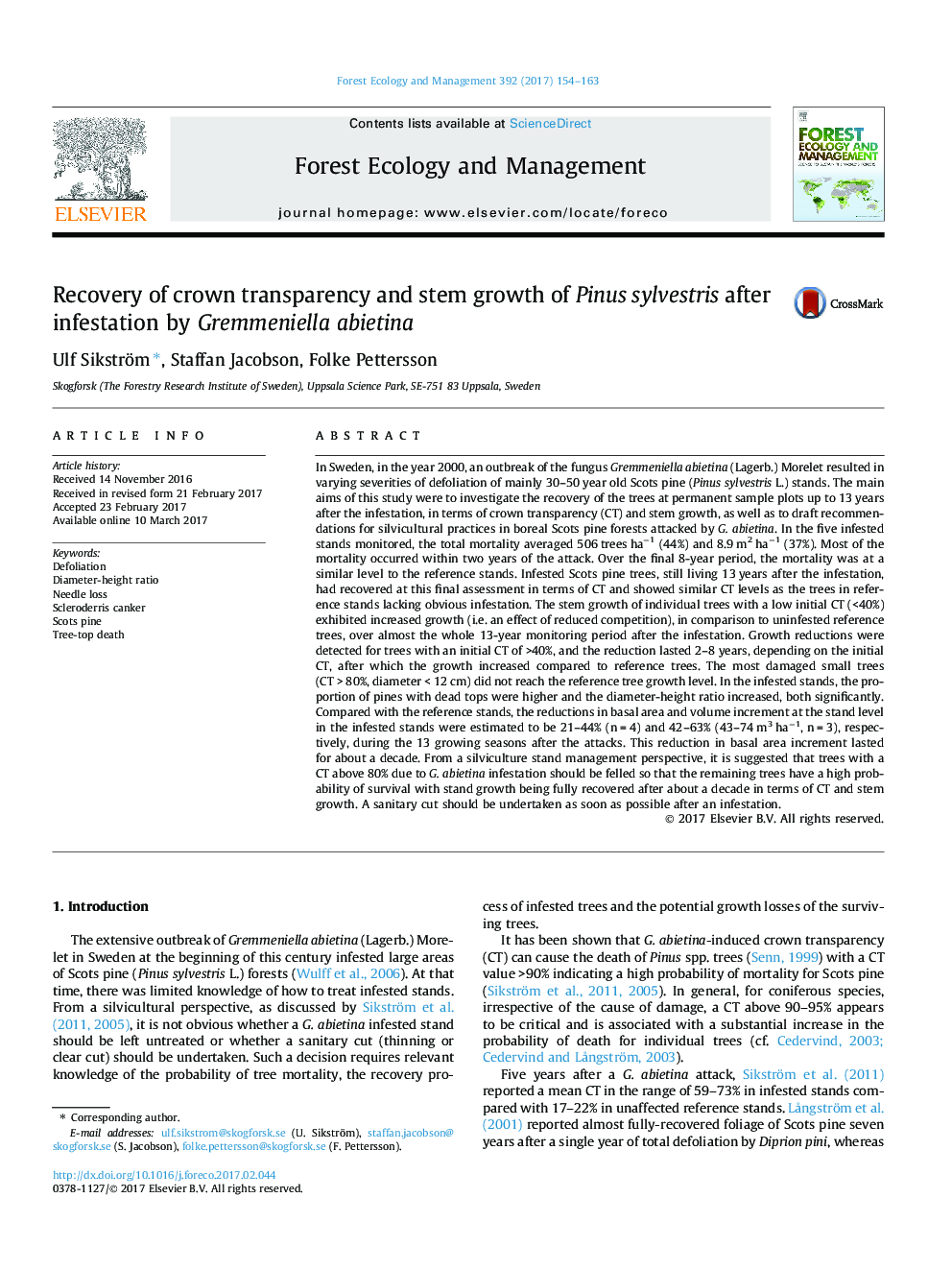| کد مقاله | کد نشریه | سال انتشار | مقاله انگلیسی | نسخه تمام متن |
|---|---|---|---|---|
| 4759474 | 1421366 | 2017 | 10 صفحه PDF | دانلود رایگان |
عنوان انگلیسی مقاله ISI
Recovery of crown transparency and stem growth of Pinus sylvestris after infestation by Gremmeniella abietina
دانلود مقاله + سفارش ترجمه
دانلود مقاله ISI انگلیسی
رایگان برای ایرانیان
کلمات کلیدی
موضوعات مرتبط
علوم زیستی و بیوفناوری
علوم کشاورزی و بیولوژیک
بوم شناسی، تکامل، رفتار و سامانه شناسی
پیش نمایش صفحه اول مقاله

چکیده انگلیسی
In Sweden, in the year 2000, an outbreak of the fungus Gremmeniella abietina (Lagerb.) Morelet resulted in varying severities of defoliation of mainly 30-50 year old Scots pine (Pinus sylvestris L.) stands. The main aims of this study were to investigate the recovery of the trees at permanent sample plots up to 13 years after the infestation, in terms of crown transparency (CT) and stem growth, as well as to draft recommendations for silvicultural practices in boreal Scots pine forests attacked by G. abietina. In the five infested stands monitored, the total mortality averaged 506 trees haâ1 (44%) and 8.9 m2 haâ1 (37%). Most of the mortality occurred within two years of the attack. Over the final 8-year period, the mortality was at a similar level to the reference stands. Infested Scots pine trees, still living 13 years after the infestation, had recovered at this final assessment in terms of CT and showed similar CT levels as the trees in reference stands lacking obvious infestation. The stem growth of individual trees with a low initial CT (<40%) exhibited increased growth (i.e. an effect of reduced competition), in comparison to uninfested reference trees, over almost the whole 13-year monitoring period after the infestation. Growth reductions were detected for trees with an initial CT of >40%, and the reduction lasted 2-8 years, depending on the initial CT, after which the growth increased compared to reference trees. The most damaged small trees (CT > 80%, diameter < 12 cm) did not reach the reference tree growth level. In the infested stands, the proportion of pines with dead tops were higher and the diameter-height ratio increased, both significantly. Compared with the reference stands, the reductions in basal area and volume increment at the stand level in the infested stands were estimated to be 21-44% (n = 4) and 42-63% (43-74 m3 haâ1, n = 3), respectively, during the 13 growing seasons after the attacks. This reduction in basal area increment lasted for about a decade. From a silviculture stand management perspective, it is suggested that trees with a CT above 80% due to G. abietina infestation should be felled so that the remaining trees have a high probability of survival with stand growth being fully recovered after about a decade in terms of CT and stem growth. A sanitary cut should be undertaken as soon as possible after an infestation.
ناشر
Database: Elsevier - ScienceDirect (ساینس دایرکت)
Journal: Forest Ecology and Management - Volume 392, 15 May 2017, Pages 154-163
Journal: Forest Ecology and Management - Volume 392, 15 May 2017, Pages 154-163
نویسندگان
Ulf Sikström, Staffan Jacobson, Folke Pettersson,